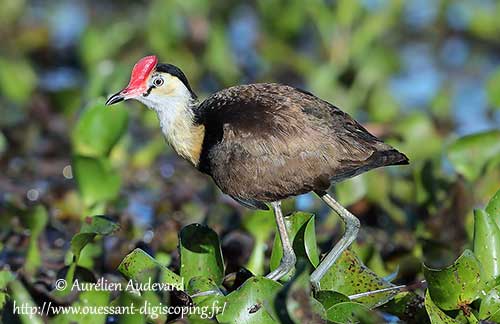
Fr: Jacana à crête
Ang: Comb-crested Jacana
All: Kammblatthühnchen
Esp: Jacana Crestada
Ita: Jacana crestata
Nd: Australische Jacana
Sd: kamjaçana
Photographers:
Aurélien Audevard
OUESSANT DIGISCOPING
Patrick Ingremeau
TAMANDUA
Otto Plantema
Trips around the world
Text by Nicole Bouglouan
Sources:
HANDBOOK OF THE BIRDS OF THE WORLD Volume 3 by Josep del Hoyo-Andrew Elliott-Jordi Sargatal - Lynx Edicions - ISBN: 8487334202
SHOREBIRDS by Peter Hayman, John Marchant and Tony Prater – Christopher Helm – 1986 – ISBN: 0747014035
The Graham Pizzey & Frank Knight Field Guide to the Birds of Australia - Publisher: HarperCollins Publishers (Australia) Pty Ltd; Reprint. Edition (1996) - ISBN-10: 020718013X - ISBN-13: 978-0207180132 - 528 pages
Field Guide to Australian Birds by Michael Morcombe - Editeur: Steve Parish Publishing Pty Ltd – ISBN-10: 187628210X -ISBN-13: 978-1876282103 - 448 pages
NSW Government - Office of Environment & Heritage
Parentage and Relatedness in Polyandrous Comb-Crested Jacanas Using ISSRs
Comb-crested jacana waterbird carrying chicks to safety captured in remarkable pictures
Birds in backyards (Birds Australia and Australian Museum)
Wikipedia, the free encyclopaedia
Comb-crested Jacana
Irediparra gallinacea
Charadriiformes Order – Jacanidae Family
INTRODUCTION:
This elegant bird with its head wearing a comb similar to a red rose petal, the colour of which varies according to its mood, is often seen walking carefully on floating and emergent vegetation in freshwater wetlands.
The Comb-crested Jacana lives, feeds and nests on tropical lagoons. The species occurs in the coastal regions of N and E Australia, and beyond Australia, from Borneo and the Philippines, Sulawesi, the Moluccas and Lesser Sundas Islands to Aru Islands, New Guinea and New Britain.
The Comb-crested Jacana is affected by degradation of wetlands and modification of the habitat.
It is not globally threatened, although it is listed as Vulnerable in some regions, but it is also locally abundant in others areas.

DESCRIPTION OF THE BIRD:
Biometrics:
Length: 21-24 cm
Wingspan: 39-46 cm
Weight: M: 75-97 g – F: 120-168 g
The Comb-crested Jacana has brown upperparts including lower mantle, back and upperwing-coverts. Hindneck, upper mantle, flight-feathers and breast are black. Belly and undertail-coverts are white. The underwing is very dark, including the axillaries.
On the head, forehead and crown are black with purplish-blue gloss. A narrow, black line extends from the base of lower mandible to the eye. Rest of face, supercilium, neck and upper breast are glossy, pale golden-yellow, but chin and throat are white.
The bill is reddish-pink with well-defined black tip. The lower mandible may appear slightly paler. The eyes are pale brownish-white to yellowish. Legs and feet are dull greyish-green. Toes and claws are very long.
There is a short, blunt knob on the carpal joint, formed by the heavily cornified leading edge along distal part of radius, but this is not a spur.
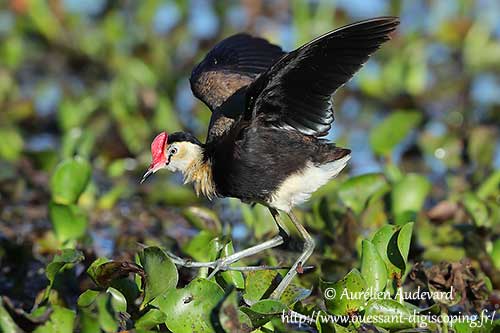
The Comb-crested Jacana shows a highly-developed, flattened, fleshy shield with a well-developed central comb. This structure ranges from yellow to pale orange when the bird is quiet and inactive. But it may become bright pinkish-red when the bird is engaged in social interactions or other situations, such as displays.
When the bird is excited, the comb is engorged with infusion of blood and becomes inflated, very similar to a red rose petal elegantly placed on the top of the head.
The female has similar plumage but she is considerably larger and heavier.
The juvenile is browner than adult on the upperparts and white below, including the breast. The underwing is black.
The crown is chestnut. Frontal wattle and comb are rudimentary.
RANGE:
The Comb-crested Jacana is sometimes divided in three subspecies by some authors, with I.g. gallinacea, I.g. novaeguinea and I.g. novaehollandiae. The racial differences may be masked by individual variations. It is treated here as a monotypic species.
The range of the Comb-crested Jacana extends from SE Borneo, Sulawesi, SE Philippines, Moluccas and Lesser Sundas to W Papuan Islands (Misool), Kai islands, Aru Islands, lowland New Guinea, Bismarck Archipelago and D’Entrecasteaux Islands. It also occurs in S New Guinea, N and E Australia S to Sydney.
HABITAT:
The Comb-crested Jacana frequents permanent freshwater wetlands with large surface cover of floating vegetation, mainly water lilies, and/or fringing and aquatic vegetation.
During the non-breeding period, it can be seen on short-grass uplands, even away from water.
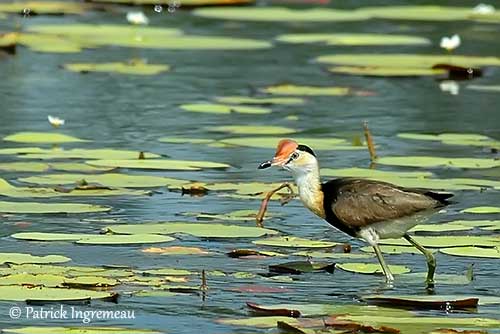
CALLS AND SONGS: SOUNDS BY XENO-CANTO
The Comb-crested Jacana is not very noisy, but it often calls and regularly gives two types of sounds.
The first call is a repeated series of notes usually given during interaction with other jacanas.
The second call includes twittering, chittering and piping notes. These calls are usually given in flight but also when the bird stands in upright stance and seems to be threatened. The alarm call is a sharp, nasal note.
BEHAVIOUR IN THE WILD:
The Comb-crested Jacana feeds on insects and various other invertebrates, and also seeds of aquatic plant and other plant materials.
The diet includes various insect species, molluscs and crustaceans. Plant materials include seeds of aquatic plants, especially water lilies. However, terrestrial plant and animal materials are also part of the diet. The diet usually varies depending on the season.
Male and female seem to feed the same food items, despite their different body sizes.
The Comb-crested Jacana forages on floating vegetation by walking with a typical bobbing and flicking gait. It always appears busy. Its weight is widely spread by the long toes.
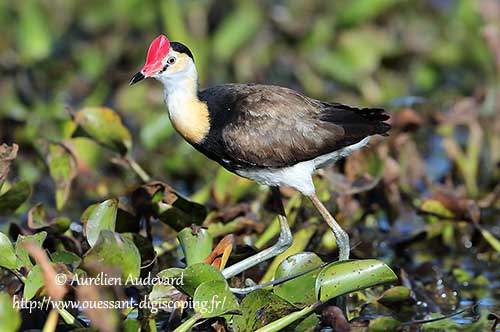
It can be seen alone, in twos, or groups and flocks of various sizes.
Outside breeding season, they are more gregarious. During severe drought in Australia, the species was known gathering in large numbers on some permanent marshes.
The Comb-crested Jacana is polyandrous and exhibits sexual role reversal. The male defends the territory, builds the nest, incubates the eggs and broods and rears the chicks.
The female may mate with several males while the male performs alone the nesting duties.
The territorial males may fight strongly and the female pecks at them until they separate.
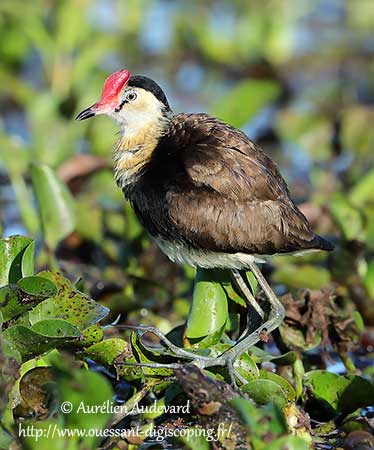
Sexual solicitations between mates involve the male mimicking the female’s posture. This behaviour is often referred to courtship display, but it does not result in mounting. It may end with both male and female soliciting before one of them goes away.
During this display, the male orientates itself towards the approaching female and performs “bow display” while gradually extending its wings laterally and rotating them. The black underwing faces the female. It also extends both head and neck under the female’s neck and rubs her feathers with its head and the bright red comb. The copulation may sometimes follow this behaviour.
The Comb-crested Jacana is sedentary on permanent wetlands, but some dispersion is reported according to the availability of flooded wetlands at the beginning of the wet season.
While flying, the long legs and feet extend beyond the tip of the tail. The Comb-crested Jacana flies swiftly with rapid, shallow wingbeats. It is able to perform long-distance flights.
On the other hand, it is also able to swim and to submerge in order to escape predators.
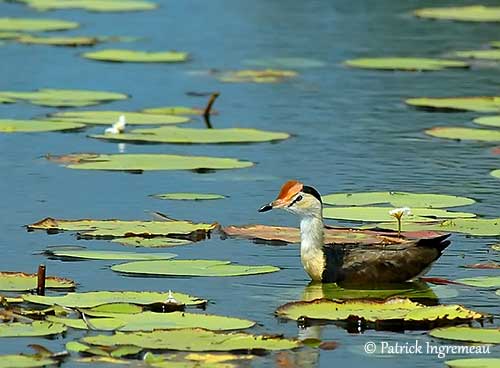
REPRODUCTION OF THE BIRD:
The Comb-crested Jacana can breed year-round when it can find permanent floating vegetation. In Australia, it breeds only during the wet season.
The male builds the nest on floating aquatic vegetation. The flimsy structure is a platform or a shallow cup made with plant materials, often stems and pieces of aquatic plants. Usually, the female does much vegetation tossing. However, sometimes, the eggs are laid directly onto a large leaf with no nest built.
The female lays 3-4 yellowish to brownish glossy eggs, heavily marked with blackish lines. If the clutch is lost, with the eggs rolling into the water, she produces a replacement clutch. This may occur for her primary male, but also for her other following mates. In the same way, the male that loses the first clutch may mate with other females.
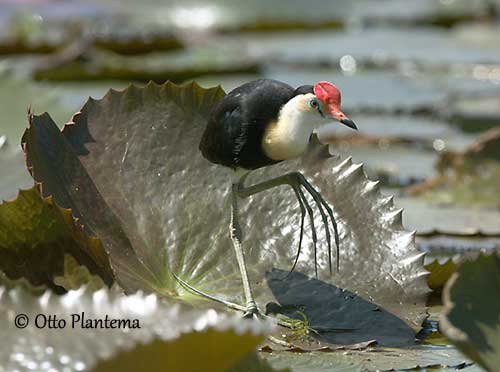
The male incubates alone during 28 days and broods the chicks. The downy chicks are striped dark above but they are white below.
They are precocial and are able to dive to escape a danger. But when they are threatened, the male picks one or two chicks up under each wing to carry them off to safety. Their dangling legs are visible beneath the male’s feathers.
The young fledge 50-60 days after hatching.
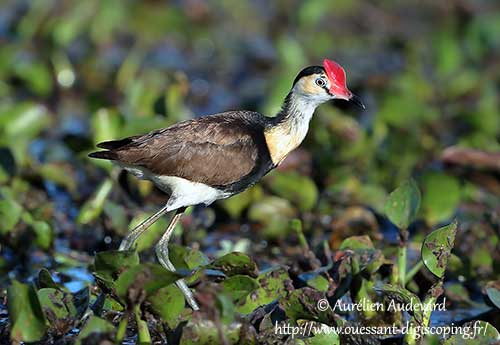
PROTECTION / THREATS / STATUS:
The Comb-crested Jacana does not appear threatened throughout most of the range, but degradation, modification and loss of wetlands is a continual threat in some regions such as New South Wales in Australia.
Introduction of non-native fish eating the aquatic vegetation is also a problem in New Guinea.
The size of the population is unknown and the trend is difficult to determine, following the impacts of degradation of the habitat throughout the range.
The Comb-crested Jacana is not considered globally threatened, and the species is currently evaluated as Least Concern.
